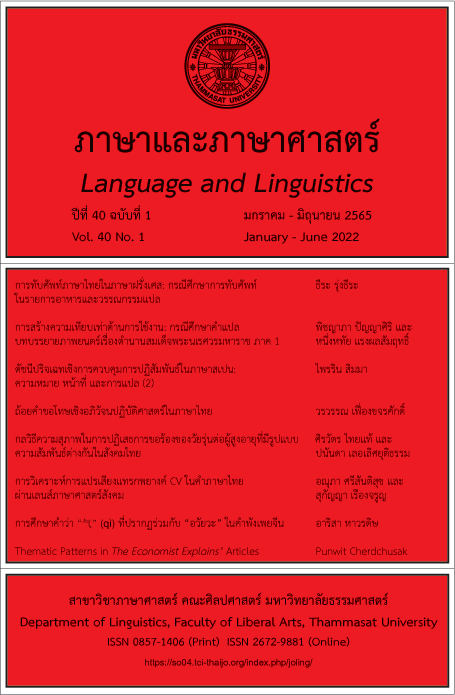Thematic Patterns in The Economist Explains’ Articles
Main Article Content
Abstract
This study examines thematic patterns in The Economist explains’ articles and aims to demonstrate how Theme (i.e., the point of departure of the message) and its patterns can facilitate reading comprehension. Ten most recent online articles from The Economist explains, a total of 47 paragraphs, comprise the data. Combining Halliday’s thematic approach (Halliday & Matthiessen, 2014) with Thompson’s approach (Thompson, 2014), the analysis reveals six different functions that the paragraphs of the articles perform. Each function expresses specific thematic patterns. The patterns capture the core information that is crucial to the understanding of the paragraphs’ contents. Thus, the patterns can help promote reading comprehension.
Article Details

This work is licensed under a Creative Commons Attribution-NonCommercial-NoDerivatives 4.0 International License.
บทความทุกบทความเป็นลิขสิทธิ์ของภาษาและภาษาศาสตร์
References
Alotaibi, H. S. (2020). The thematic structure in research article abstracts: Variations across disciplines. Cogent Arts & Humanities, 7(1), 1-12.
Berry, M. (2019). The clause: An overview of the lexicogrammar. In G. Thompson, W. L. Bowcher, L. Fontaine, & D. Schönthal (Eds.), The Cambridge handbook of systemic functional linguistics (pp. 92-117). Cambridge University Press.
Chan, E., & Zhang, Z. (2017). Teaching reading through multimodal texts. In H. P. Widodo, A. Wood, & D. Gupta (Eds.), Asian English language classrooms: Where theory and practice meet (pp. 49-70). Routledge.
Chen, Q. (2019). Theme-Rheme structure in Chinese doctoral students' research writing—from the first draft to the published paper. Journal of English for Academic Purpose, 37, 154-167.
Forey, G., & Sampson, N. (2017). Textual metafunction and theme: What’s ‘it’ about?. In T. Bartlett & G. O’Grady (Eds.), The Routledge handbook of systemic functional linguistics (pp. 131-145). Routledge.
Halliday, M. A. K., & Matthiessen, C. (2014). Halliday’s introduction to functional grammar (4th ed.). Routledge.
How to knit a sports car with carbon fibre. (2019, April 13). The Economist. https://www.economist.com/science-and-technology/2019/04/13/how-to-knit-a-sports-car-with-carbon-fibre
Leong, A. P. (2015). Topical themes and thematic progression: The “picture” of research articles. Text & Talk, 35(3), 289-315.
Leong, A. P., Toh, A. L. L., & Chin, S. F. (2018). Examining structure in scientific research articles: A study of thematic progression and thematic density. Written Communication, 35(3), 1-29.
Martinez-Insua, A. E. (2019). Scientific writing and the contentfulness of Subject Themes. How science was explained to (lay) audiences. Journal of Pragmatics, 139, 216-230.
Martinez-Insua, E., & Perez-Guerra, J. (2018). Text types, audience and thematic organization in the recent history of English. In D. Legallois, T. Charnois, & M. Larjavaara (Eds.), The grammar of genres and styles: From discrete to non-discrete units (pp. 14-38). De Gruyter Mouton.
Neumann, S., Wegener, R., Fest, J., Niemietz, P., & Hützen, N. (2017). Challenging boundaries and bending rules: An introduction. In S. Neumann, R. Wegener, J. Fest, P. Niemietz, & N. Hützen (Eds.), Challenging boundaries in linguistics: Systemic functional perspectives (pp. 9-15). Peter Lang.
OECD (2019). PISA 2018 Results. https://www.oecd.org/pisa/PISA-results_ENGLISH.png
Taboada, M. (2019). Cohesion and conjunction. In G. Thompson, W. L. Bowcher, L. Fontaine, & D. Schönthal (Eds.), The Cambridge handbook of systemic functional linguistics (pp. 311-332). Cambridge University Press.
Thompson, G. (2014). Introducing functional grammar (3nd ed.). Routledge.
Vathanavisuth, S. (2019, December 18). Reading as a way to a better life. Bangkok Post.


